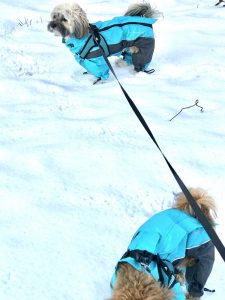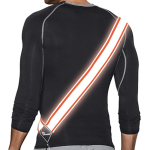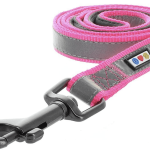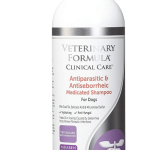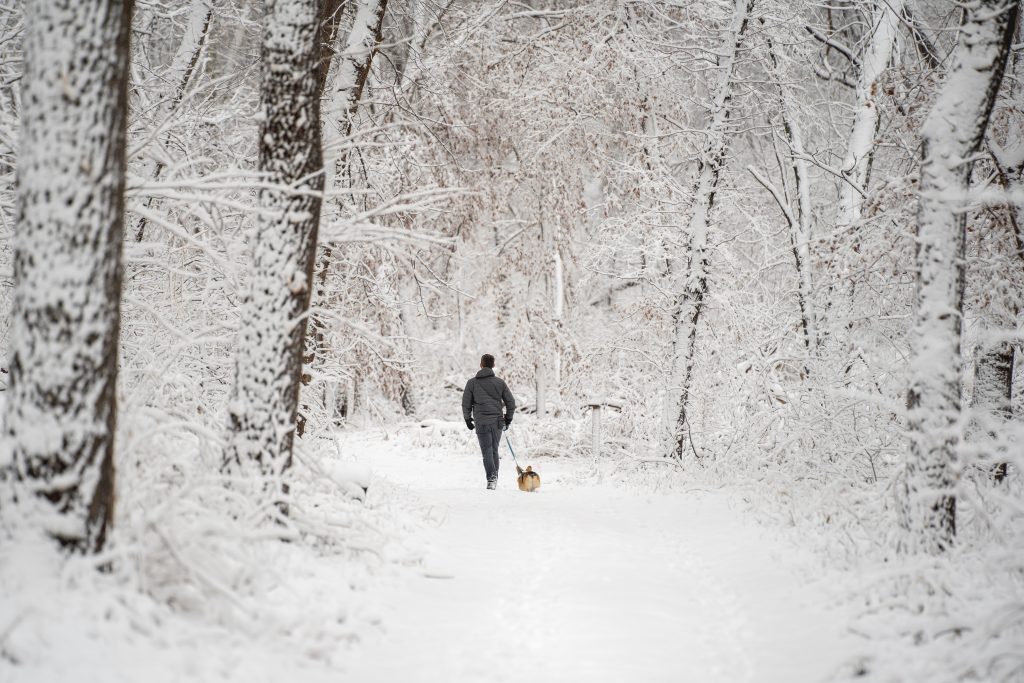
By Umphreys via Unsplash
(Note: This post may contain affiliate links for your shopping convenience and to help support our work. The non-Amazon links are not affiliate, but they’re there because we want you to have quick access to products we believe in or are interested in regardless of whether we earn a commission. Our full disclosure, disclaimer, and copyright notices are found here. )
In a hurry? Scroll down for our Small Bites Quick Guide: Keeping Your Small Dog Safe In Winter.
Winter, approached with the right mindset, can be a whole lot of fun. Bringing our small dogs out and about is incredibly important to keep us all from going stir-crazy indoors. Regardless of the rain, sleet, or snow, we humans and our small canine companions still need fresh air, exercise, and connection to nature to safeguard our mental and physical health.
But are we doing all we should as pet parents to keep our small dogs safe during cold winter weather? We asked ourselves this question and found a few things we could be doing better. Read our research below to find the latest advice to protect your dog from winter hazards. We’ve organized the information chronologically for easy reference, so you’ll know what to do before, during, and after your outdoor adventures so your small dog is safe in the snow.
What To Do Before Heading Outdoors With Your Small Dog in Winter
1. Winterize Your Pup

Photo: Lyfor via Unsplash
Chat With Your Vet: Just as we winterize our cars and homes, we should be winterizing ourselves, including our pups. Especially if your small dog is older or has any chronic illnesses, do some preventative veterinary care and talk with your vet about how to control arthritis pain made worse in the winter or whether your dog’s health issues might make them more likely to suffer cold-related injuries. Blood or heart conditions can make it more difficult for your small dog to regulate body temperature when the weather becomes dangerous. Knowing that will dictate the protective dog clothing you’ll want to provide and the length of your stay outdoors.
2. Prepare their Paws
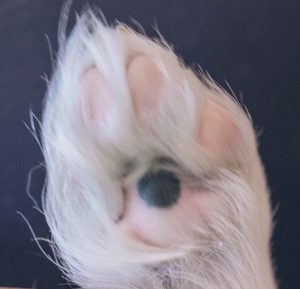
by Flouffy via Unsplash
Your dog’s paws need protection not merely from the cold, ice, and snow but also from the corrosive salt and sand on sidewalks and roads. You’d think that booties are the answer, but so many dogs refuse to keep them on, and many dog parents worry that the booties will interfere with a dog’s gait. And, most veterinary sites we consulted said that your dog’s need for boots really depends on how your pup reacts…if your dog doesn’t seem bothered by walking on the snow, then likely booties aren’t required for warmth. Having said that, it does make US cold looking at their little feet in the snow, and so we have tried multiple boots to no avail. The dogs are clearly happier going bootless.
It seems we’re in good company, as our small dog blog idol Jessica Rhae of You Did What With Your Weiner and her hardy dachshunds also leave the boots at home even when they venture into mountain snow (as long as it’s not below 25 degrees out!). We loved her science-minded explanation of why dog feet don’t become cold in the same way ours do, AND we love that she explains there’s a big, dangerous difference between cold feet and hypothermia. Like us, she reminds readers that our dogs’ experiences aren’t necessarily what’s best for your dog, and that you need to talk to your own vet about whether your pup and your climate warrant wearing dog boots (for your pup, not you. Obviously…). Read more in Jessica’s article Does My Small Dog Need To Wear Boots In The Snow? and follow her on IG @youdidwhatwithyourweiner. We live a vicarious adventure and feel inspired every time we read her blog or enjoy her Instagram posts.
Instead of boots, Dr. Marty Becker does suggest topical paw protectants can work, if not to keep your dog warm in winter, at least to prevent chafing and provide a barrier between paw pads and salts or melting chemicals. 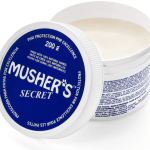
3. Bundle Up In Coats and…. Dog Snoods?
Although we enjoy looking at dressed-up pups as much as the next dog fanatic, our mantra is “we take small dogs seriously,” and we don’t focus on unnecessary clothing. We want our dogs to live doggy lives (though we respect and appreciate the fun dress-up occurring in other pet families!). To us, living a full doggy life means being outdoors in all sorts of weather, and most small dogs aren’t built for withstanding harsh weather conditions in their birthday suits. They don’t have double coats, and many toy breeds originated in tropical climates. They generally have single coats, little body fat, and because they’re low to the ground, they lose body heat quickly.
For that reason, most vets recommend that small breeds wear coats when the frigid weather hits. A coat not only provides a necessary layer of warmth, it acts to keep snow balls from forming on the belly or legs and causing a dangerous drop in your dog’s body temperature. For the same reason, some breeds with unprotected ears 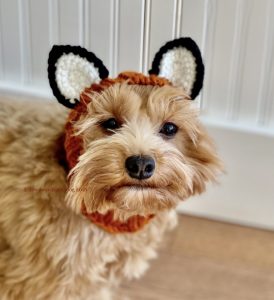
4. May We See Your Identification, Please?
According to the American Veterinary Medical Association, winter’s snow and ice can mask the familiar scents that can help a lost dog find her way home quickly. So, it’s even more important than usual to be sure your dog has multiple means of identification. We use both a riveted dog tag and registered microchips. And, we ask our vet to read the chips periodically just to be sure they’re still working properly. Of course, we don’t let the dogs out of our sight, but even the most careful pet guardians can have careless house guests or sudden events causing a beloved dog to panic and run.
Keeping Safe While Outdoors With Your Small Dog in Winter
Once outdoors, after we’ve taken a deep breath of bracing cold air, the hard part of protecting our pups from the winter weather is done–the vet advice, the updated identification, and the bundling up. But, we can’t relax completely. Because more dangers lurk outdoors in winter, we have to watch our dogs with extra care even while enjoying all that nature has to offer. It’s especially important to have extra vigilance in ice and snow, as the following hazards lurk. Most of us know all this, but we do that human thing where we think “it won’t happen to us”:
1. Treacherous Traffic: Be Visible
Okay, we feel a little like your mother warning you of this one, but it’s true: pedestrian accidents increase in winter months when sidewalks may be unwalkable and darkness sets in early.
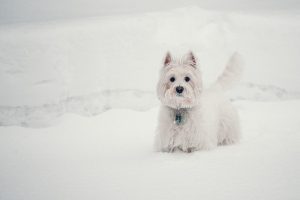
By Trapani via Unsplash
Be hyper-vigilant–listen and watch for traffic, and if you must walk in the road, walk facing traffic so you see oncoming cars. Use reflective leashes for your pup and a reflective vest for yourself.
2. Slip And Fall
The snow and ice itself pose physical dangers in two ways: an immediate increased risk of slipping and falling, both for you and your dog. And if one of you goes down, it’s likely the other will too. Watch your step.
3. Thin Ice
Likewise, avoid altogether stepping on frozen lakes or ponds alone –and if you’re with others you should venture onto the surface only if you’re positive the ice layer is solid and deep. Whatever you do, don’t let your pup off-leash.

By Ellis via Unsplash
Even small dogs can weigh enough to break through thin spots on partially-frozen ponds, and so many tragic dog drownings occur every year it simply makes sense to be conservative and safe.
4. Chemical Burns and Ice/Snow
Rock salt, snow melt, and collected snow in the pads can injure paws quickly, so take frequent breaks to check the bottom of your pup’s feet for any issues. We bring along a dog wipe and just periodically swipe the bottom pads. Hopefully that won’t be necessary when the Musher’s Secret arrives, as Phoebe and Scout do NOT appreciate our ministrations while they’re on a healthy trot!
5. Antifreeze Can Kill Quickly
This one shocked us, although we always knew antifreeze was poisonous. We just didn’t understand how little it takes. Antifreeze spills from cars parked in roadways can kill a small dog–even one who walks through it and then licks his paws after, and as little as 5 tablespoons is fatal to a medium-sized dog. It’s so important we not let our pups walk through puddles or drink water sources outdoors.
6. Parasites That Thrive In Cold
Another surprise for us was that certain dangerous parasites causing major intestinal havoc LOVE the cold weather and actually thrive in it. Giardia (we wrote about Phoebe’s struggle with it in our blog post Balanced Diets for Small Dogs) can survive for months in the cold, lurking in puddles or damp areas, whereas it dies off relatively quickly in warm weather. Trust us when we tell you you do NOT want your pup dealing with weeks of diarrhea and the harsh treatment required to kill off the parasite. Watch what your pup tries to eat or drink while walking. Keep them away from puddles and other dog’s waste at all costs.
Before Settling In For A Long Winter’s Nap
Most of us think the biggest danger involving our dog’s feet arises from a physical injury – scrapes or irritated paws. Unfortunately, often the greatest chance for major illness arises from what dogs track in on their feet. As noted above, antifreeze on the paws can kill a small dog if she ingests it, and salt or snow melt might not kill them, but it can wreak havoc on their sensitive gums and GI systems. Because dogs use their tongues to soothe small discomforts or to tidy up that bit of gross stuff tucked between their paws, it’s imperative that we get there first to clean up any hazards.
With small dogs, doing so is so remarkably easy. Using the utility sink (though the kitchen sink works just as well), we put about an inch of warm water and a bit of the anti-parasitic, anti-fungal, and antibacterial dog shampoo we keep on hand for minor skin irritations. From there, it’s a quick job to ensure paws are clean and the undercarriage is rinsed free from the road sand kicked up from our walk.

By Home Via Unsplash
We grab a fluffy towel, wrap them up, and do one last check of their paws as we’re drying them off. All in, the job is done in five minutes. Now, we all settle in for hot chocolate. Well, the humans are ready for hot chocolate – Phoebe and Scout get bully sticks.
That’s it! Once you’ve got the routine down, these extra safety steps add only another 15 minutes or so to an outdoor adventure. That’s certainly a fair investment in exchange for keeping your small dog happy in winter.
For easy reference, we’ve condensed this post below and provided a shopping list in our Small Bites Quick Guide: Keeping Your Small Dog Safe In Winter.
(Note: The Small Bites Quick Guide contain affiliate links for your shopping convenience and to help support our work. Our full disclosure, disclaimer, and copyright notices are found here. )
Small Dog Winter Shopping List
Small Bites: Keeping Your Small Dog Safe In Winter
Before The Winter Walk |
Notes |
| Consult Your Vet | Ask about how health issues might impact your pup’s cold weather health. Check microchip! |
| Protect Their Paws | Use booties or paw protectant. |
| Bundle Up in Coats and Hats | Small dogs need a layer of warmth for their body and to keep snow, salt, and ice off their bellies. Exposed ears might need hats or snoods! |
| Update Identification | Double-check collar and harness identification. Be sure your microchip registration is up-to-date! |
During The Winter Walk |
Notes |
| Watch for Traffic | Autumn and Winter months see increased pedestrian/car accidents. |
| Beware of Ice | Dogs can slip on ice too and seriously injure themselves. Be on the lookout. |
| Avoid Road Chemicals/Salt | These chemicals can cause physical burns on pads and if licked can damage sensitive mouth tissue or worse, result in poisoning. |
| Antifreeze Risk | Mere tablespoons of antifreeze can create life-threatening organ damage. |
| Parasite Danger | Giardia, an intestinal parasite that can create major GI issues for your small dog, thrives in cold weather. |
After The Winter Walk |
Notes |
| Clean | Wipe down paws well, and if you at all suspect your pup walked in something, use a bit of medicated shampoo and an inch of water in the sink to clean up their paws and undercarriage. |
| Chillax | Hot chocolate for humans, bully sticks for the pups |
You’ll Also Love
Leave a Reply
Your email address will not be published.

